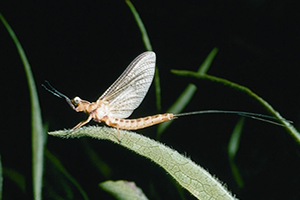Photo Credit: Kansas Department of Agriculture, Bugwood.org. Creative Commons Attribution-Noncommercial 3.0 (CC BY-NC 3.0 US) License, https://creativecommons.org/licenses/by-nc/3.0/us/
Hexagenia spp.
Common Name: mayfly
Animal Guild: Insect
Class > Order > Family: Insecta > Ephemeroptera > Ephemeridae
